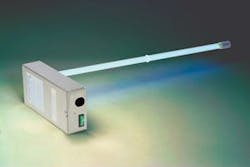Germicidal UVC Lights Improve Clinical Pregnancy Rates for IVF Lab
A seven and a half-year study conducted in the In Vitro Fertilization Cleanroom Laboratory of the Lehigh Valley Hospital and Health Network found that the use of ultraviolet C or “UVC” lights installed in the HVAC system had a clinically significant impact on clinical pregnancy rates (CPR). In presenting the findings at the annual meeting of the American Society for Reproductive Medicine (ASRM), Kathryn C. Worrilow, Ph.D. reported that the + beta and CPR increased by an average of 17.8% and 18.2%, respectively, following 10 of the 13 change-outs of the Steril-Aire UVC Emitters™ over the test period.
Clinical success in an IVF lab is critically dependent upon the quality of the ambient air, which in turn, is directly dependent upon the HVAC system. The study led by Dr. Worrilow tracked three key components in the HVAC system – particulate filters, gas phase filters and UVC lights – and the timing of their replacement - to determine whether these individual components affected markers of preimplantation embryogenesis and clinical pregnancy rates.
According to the findings, “There were no statistically significant differences… associated with the replacement of the particulate or gas phase filters in Testing Quarters 1-48. In contrast, immediately following 10 of the 13 UVC Emitter change-outs, the + beta hCG and clinical pregnancy rates increased 17.8% and 18.2%, respectively.”
The study goes on to say: “UVC energy will destroy 90 – 99% of airborne microbial contaminants. By targeting the DNA and RNA of microorganisms, UVC degrades and abates the proliferation of airborne and surface embryotoxic organics. Of equal significance to the developing embryo is the suggested impact of UVC irradiation on the degradation of VOCs. Our work has demonstrated that VOC levels as low as 2.2 ppb can be embryotoxic to the embryo cultured in vitro.”
The authors conclude: “Although the use of UVC light represents a departure from the standard HVAC design used in many IVF laboratories, the current study suggests that the use of UVC germicidal technology in the HVAC system serving the IVF laboratory may play a critical role in providing optimal ambient air towards improved clinical outcomes. The current study demonstrated that a clinically significant relationship existed between the replacement of the UVC Emitters and the associated clinical pregnancy rates.”
Robert Scheir, Ph.D., president of Steril-Aire, Inc., states: “This new data provides scientific evidence of the germicidal benefits of UVC technology. The potential benefits are far-reaching: not only for the potential to improve CPR in IVF clinics, but also for enhancing infection control in hospitals and healthcare environments, and for maintaining better ambient air in medical and pharmaceutical manufacturing clean rooms.”
Scheir adds: “The study also confirms the importance of adequate UVC output and changeout frequency in achieving desired results. The study used high-output Steril-Aire UVC lamps with a changeout schedule of 6-9 months. In the 3 of 13 UVC replacement test quarters that did not result in improved clinical pregnancy rates, outside factors may have played a role in the outcomes. As long as the lamps were functioning properly and were changed on schedule, results were consistently positive. The message to anyone using UVC is that it is critical to select a device with adequate output and to replace the device consistently at required intervals to maintain that output. Otherwise, germicidal effectiveness will be diminished.”
